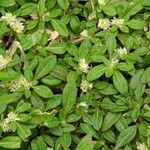Herbs perennial. Stem densely barbellate hairy, glabrescent. Leaf blade oblanceolate or spatulate, 1.5-2 × 0.3-0.5 cm, abaxially barbellate hairy, apex obtuse to rounded. Heads sessile, ovoid to globose, often hairy at base. Tepals white, ovate-oblong, scarious, hairy along veins, outer 3 segments: 3-veined in proximal half, inner 2 somewhat laterally compressed, 1-veined, apex acute to mucronate. Stamens 5; anthers yellow, ellipsoid; staminodes 3-or 4-toothed, ca. 1/2 as long as stamens; stigma capitate. Utricle brown, obcordate.
A herb. It lies along the ground. It has white hairs. The leaves are opposite. They are spoon shaped and have a short leaf stalk. The flowers are in the axils of leaves.





